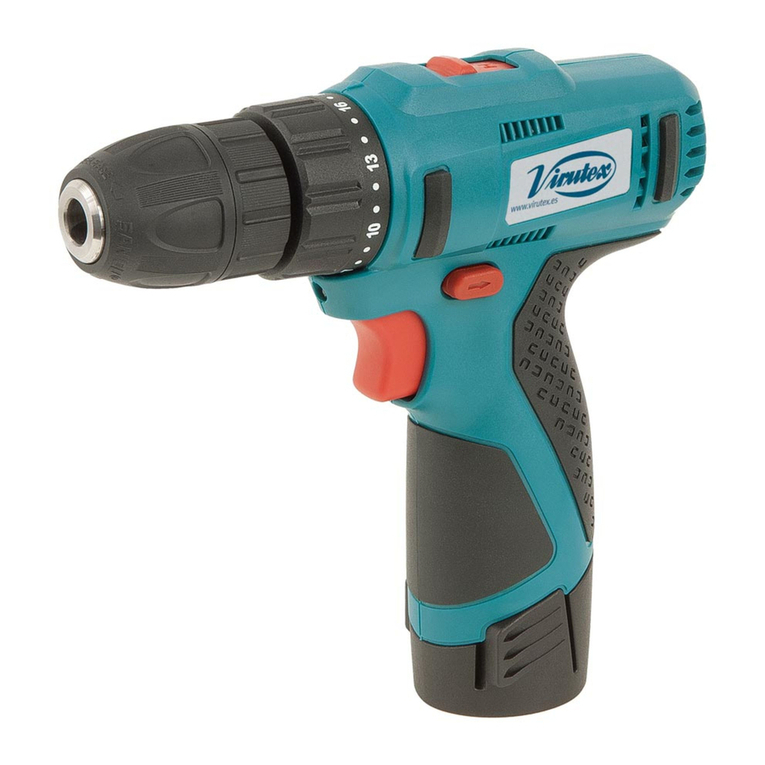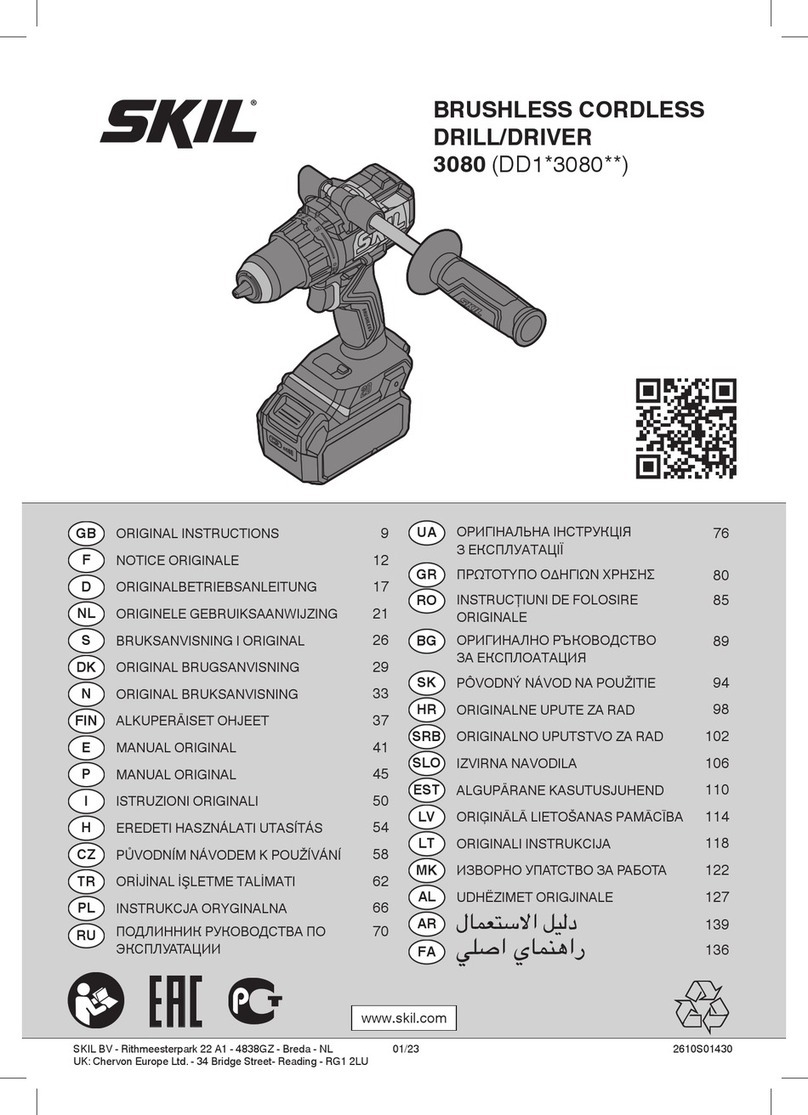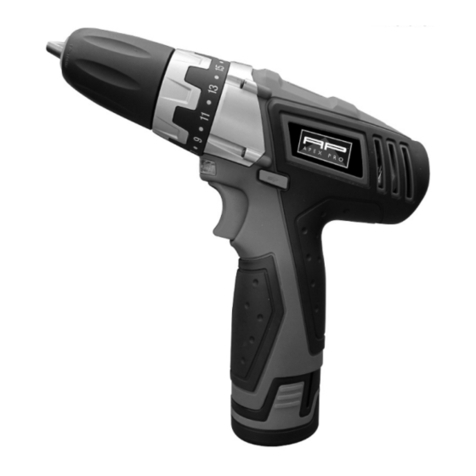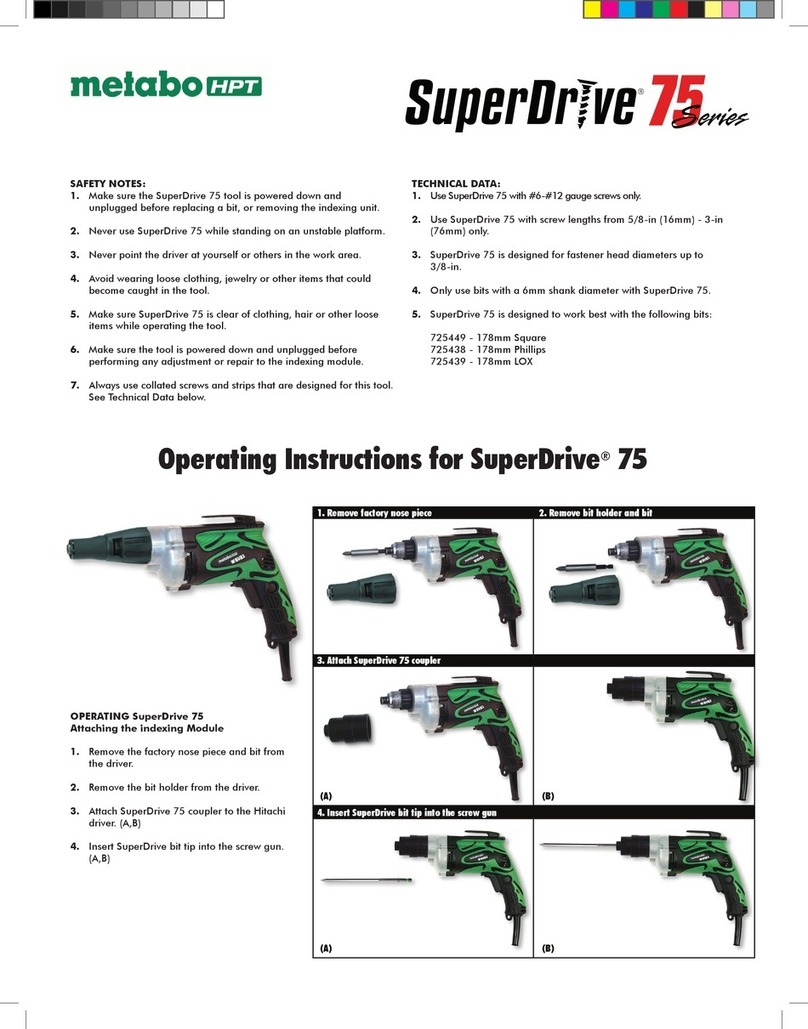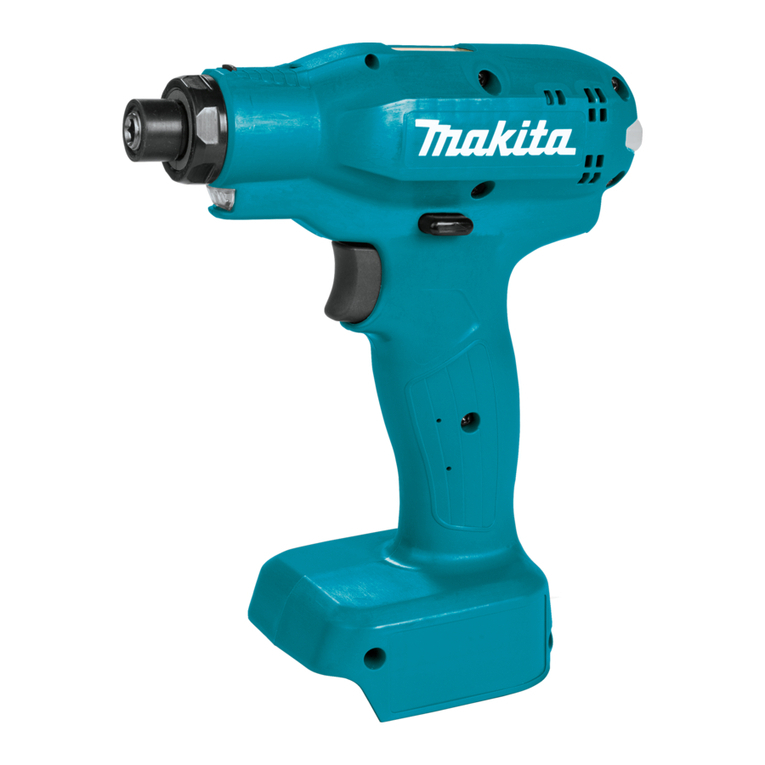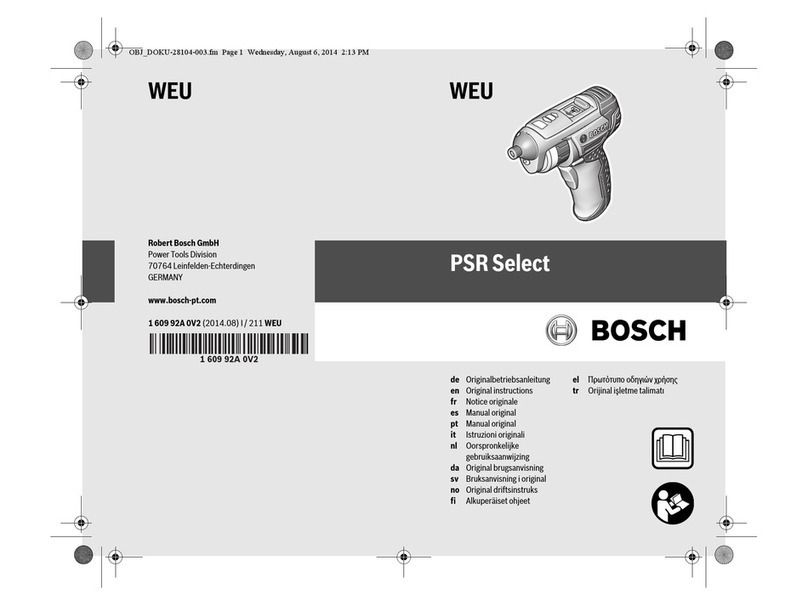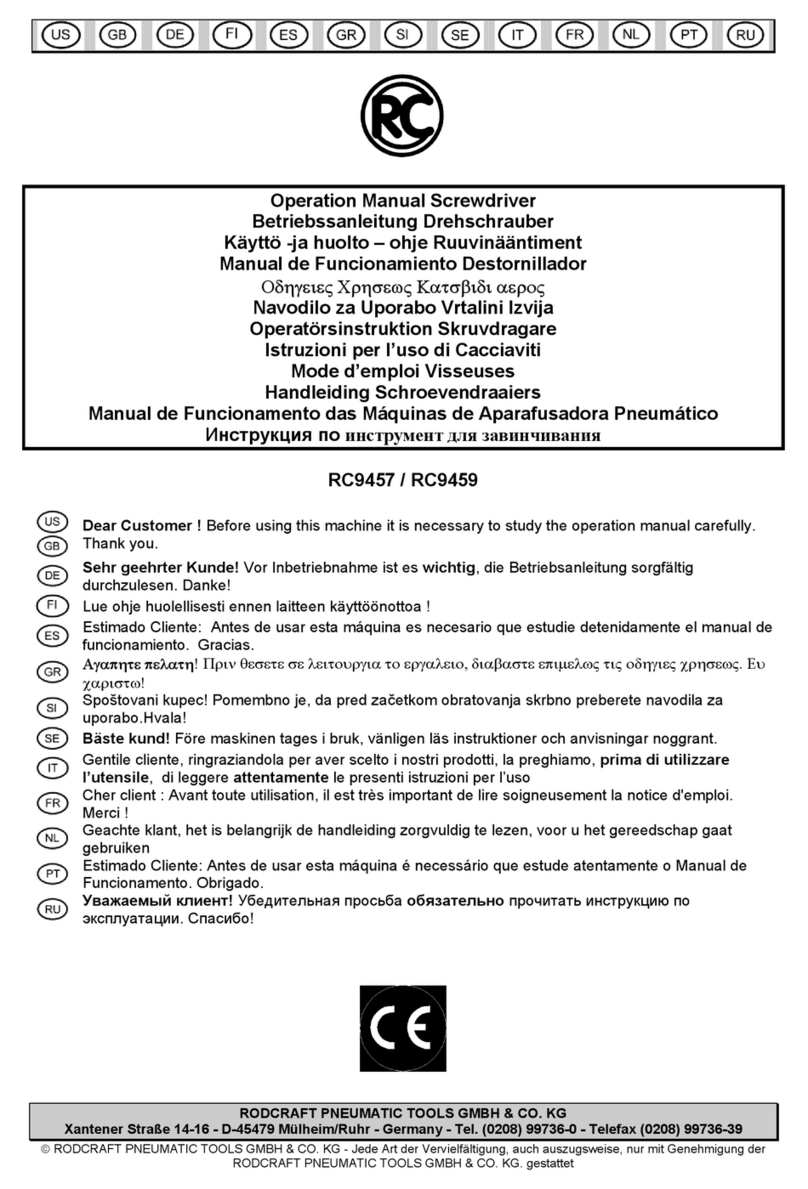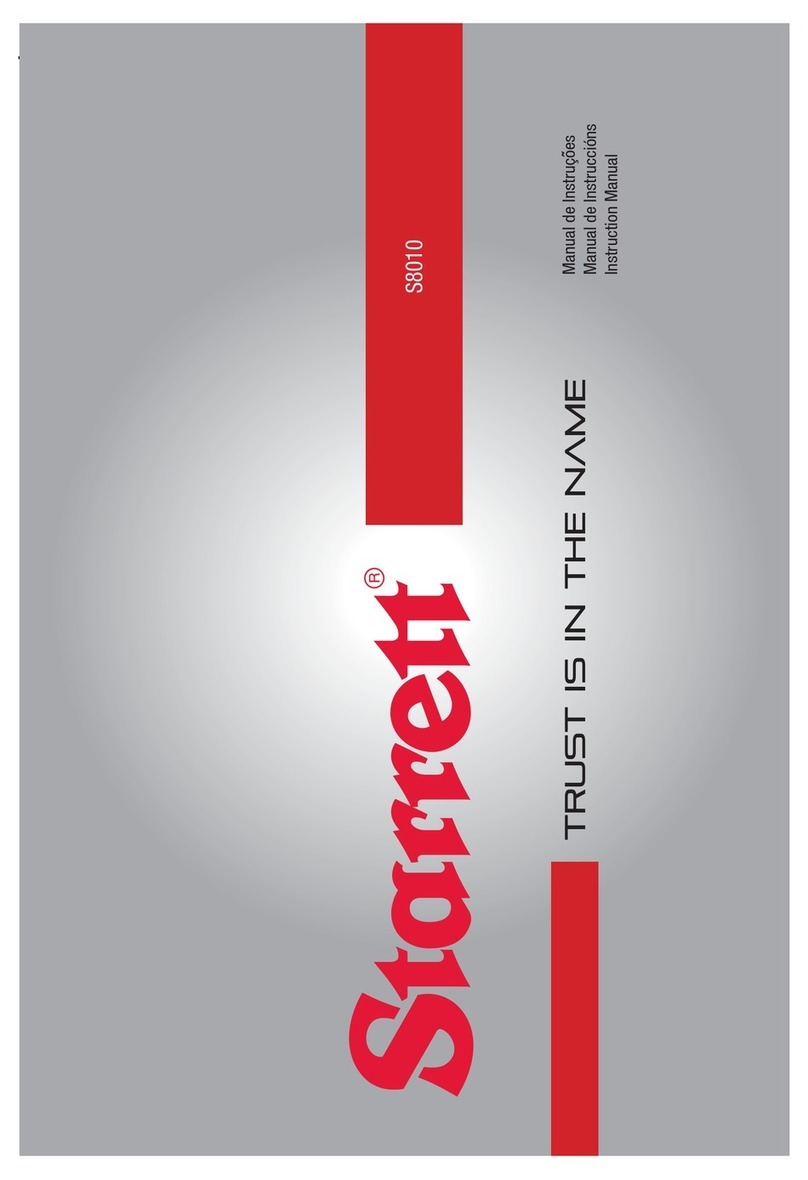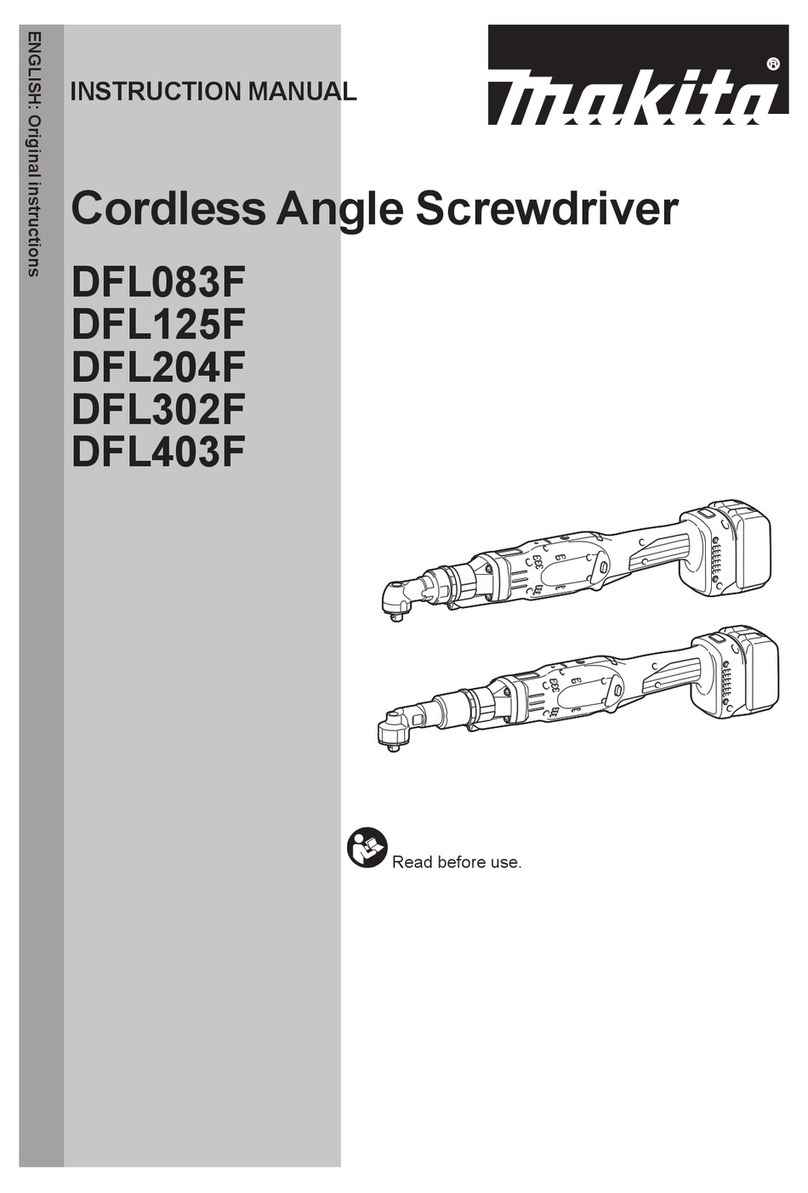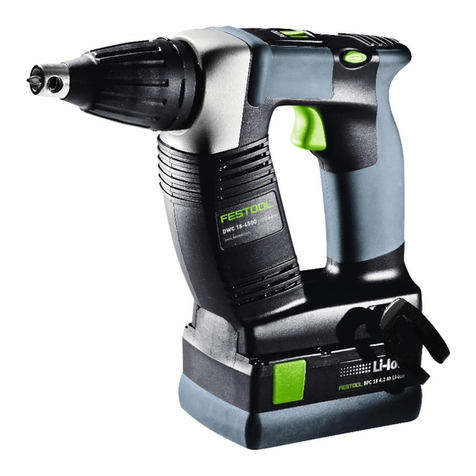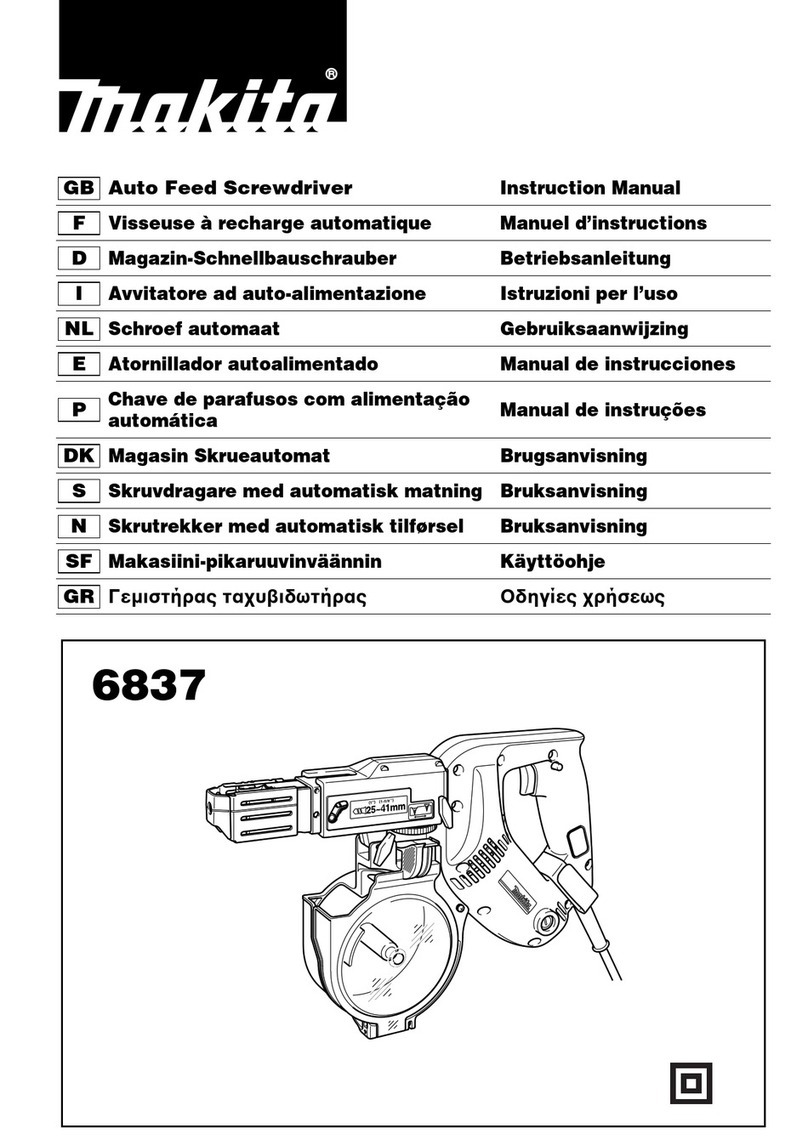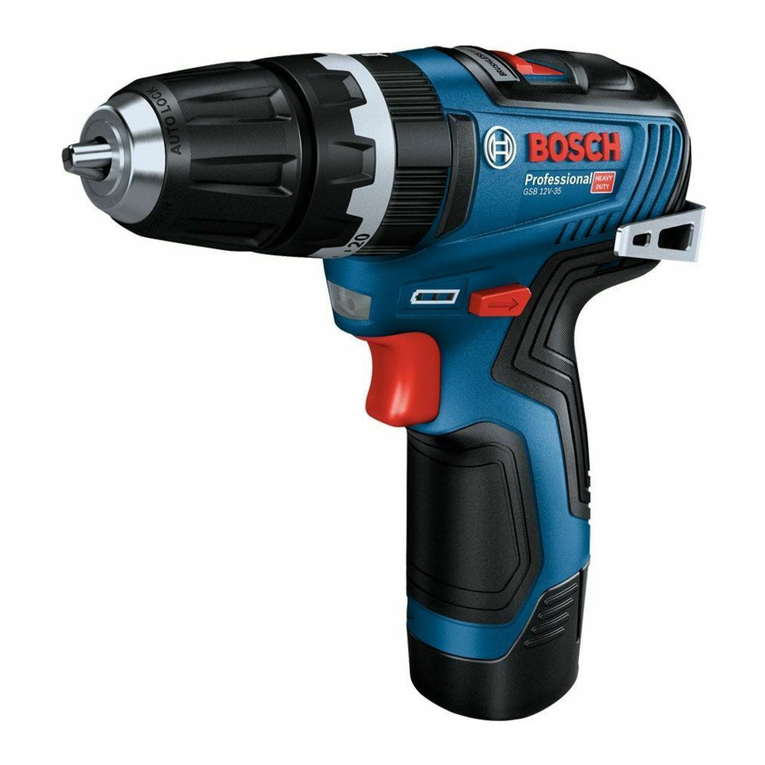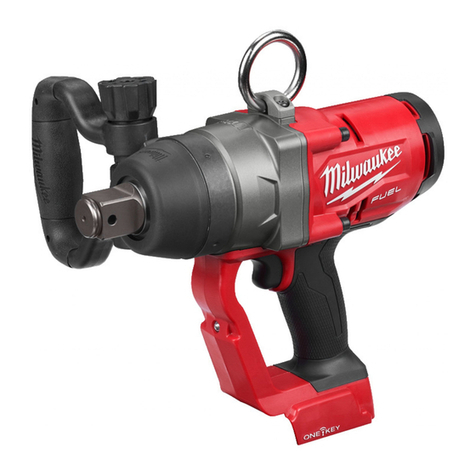Virutex ATB80P User manual

Taladro percutor / Atornillador a batería
Cordless impact screwdriver
Perceuse / Visseuse à percussion sans fil
Akku-Schlagbohrschrauber
Trapano avvitatore con percussione a batteria
Berbequim de percussão a bateria
Аккумуляторная ударная дрель-шуруповерт
Akumulatorowa wiertarko-wkrętarka udarowa
ATB80P
MANUAL DE INSTRUCCIONES
OPERATING INSTRUCTIONS
MODE D’ EMPLOI
GEBRAUCHSANWEISUNG
MANUALE D’ISTRUZIONI
MANUAL DE INSTRUÇÕES
ИНСТРУКЦИЯ ПО ЭКСПЛУАТАЦИИ
INSTRUKCJA OBSŁUGI

2
1*
MANUAL DE INSTRUCCIONES
OPERATING INSTRUCTIONS
MODE D'EMPLOI
GEBRAUCHSANWEISUNG
MANUALE D'ISTRUZIONI
MANUAL DE INSTRUÇÕES
ИНСТРУКЦИЯ
ПО
ЭКСПЛУАТАЦИИ
INSTRUKCJA OBSŁUGI
página/page
seite/pagina
страница/strona
Fig. 2
ESPAÑOL Taladro percutor / Atornillador a batería ATB80P
7
ENGLISH ATB80P Cordless impact screwdriver
14
FRANÇAIS Perceuse / Visseuse à percussion sans fil ATB80P
20
DEUTSCH Akku-Schlagbohrschrauber ATB80P
27
ITALIANO Trapano avvitatore con percussione a batteria ATB80P
33
PORTUGUÉS Berbequim de percussão a bateria ATB80P
40
РУССКИЙ Аккумуляторная ударная дрель-шуруповерт ATB80P
46
РOLSKI Akumulatorowa wiertarko-wkrętarka udarowa ATB80P
53
2*
20
4
5*
8* 9
10
21
11
15* 16*
12
6*
7*
13
14*
15*
1* 1*
1*
Fig. 1

3
Fig. 4
Fig. 3
Fig. 5
11
2*
8*
2* 2*
20
20
20
20 20 20 24 20

4
Fig. 7
Fig. 6
Fig. 8
24 20
20 20 20
23* 25* 23*
5* 15* 15* 16* 15* 15*

5
Fig. 11
Fig. 9
16*
28*
27*
26*
26*
Fig. 10
7*
7*6*
6* 15*
21 21

6
Fig. 14
Fig. 13
Fig. 12
12 12

7
Fig. 15
Fig. 16
ESPAÑOL
TALADRO PERCUTOR / ATORNILLADOR
A BATERÍA ATB80P
Importante
1. INSTRUCCIONES DE SEGURIDAD
1.1INSTRUCCIONESGENERALESDESEGURIDAD
Antes de utilizar la máquina lea atenta-
menteésteMANUALDEINSTRUCCIONES
Asegúrese de haberlo comprendido antes
de empezar a operar con la máquina.
Conserve todas las advertencias e instrucciones para
referenciaenelfuturo. Eltérmino "herramientaeléctrica"
en las advertencias se refiere a la herramienta eléctrica
accionada por la red eléctrica (con cable) o a una he-
rramienta eléctrica accionada por batería (sin cable).
Leaestasinstrucciones.Lanoobservación
de todas las instrucciones relacionadas a
continuación puede dar como resultado
un choque eléctrico, fuego y/o una le-
sión seria.
1) Área de trabajo
a) Mantenga el área de trabajo limpia y bien iluminada.
Las áreas desordenadas y oscuras provocan accidentes.
b) No maneje herramientas eléctricas en atmósferas ex-

8
mienta eléctrica. Una llave o herramienta dejada unida
a una pieza rotativa de una herramienta eléctrica puede
causar un daño personal.
e) No se sobrepase. Mantenga los pies bien asentados
sobre el suelo y conserve el equilibrio en todo momento.
Estopermite unmejorcontroldela herramientaeléctrica
en situaciones inesperadas.
f) Vista adecuadamente. No vista ropa suelta o joyas.
Mantenga su pelo, su ropa y guantes elejados de las
piezas en movimiento. La ropa suelta, las joyas o el pelo
largo pueden ser cogidos en las piezas en movimiento.
g) Si hay dispositivos para la conexión de medios de
extracción y recogida de polvo, asegúrese de que éstos
estén conectados y se usen correctamente. El uso de
estos dispositivos puede reducir los riesgos relacionados
con el polvo.
4) Utilización y cuidados de las herramientas eléctricas.
a)Nofuerce la herramientaeléctrica.Usela herramienta
eléctrica correcta para su aplicación. La herramienta
eléctrica correcta hará el trabajo mejor y más seguro
al ritmo para la que fue concebida.
b)Nouse laherramienta eléctricasiel interruptornogira
“cerrado” y “abierto”. Cualquier herramienta eléctrica
que no pueda controlarse con el interruptor es peligrosa
y debe repararse.
c) Desenchufe la cjavija de la fuente de alimentación y
o batería antes de efectuar cualquier ajuste, cambio de
accesorios, o de almacenar las herramientas eléctricas.
Talesmedidaspreventivas deseguridad reducenelriesgo
de arrancar la herramienta accidentalmente.
d) Almacene las herramientas eléctricas inactivas fuera
del alcance de los niños y no permita el manejo de la
herramienta eléctrica a personas no familiarizadas con
las herramientas o con estas instrucciones. Las herra-
mientas eléctricas son peligrosas en manos de usuarios
no entrenados.
e) Mantega las herramientas eléctricas. Compruebe que
las partes móviles no estén desalineadas o trabadas, que
no haya piezas rotas u otras condiciones que puedan
afectarel funcionamientodelas herramientaseléctricas.
Las herramientas eléctricas se reparan antes de su suo,
cuando están dañadas. Muchos accidentes son causados
por herramientas eléctricas pobremente mantenidas.
f) Mantenga las herramientas de corte afiladas y limpias.
Las herramientas de corte mantenidas correctamente
con los bordes de corte afilados son menos probables
de trabarse y más fáciles de controlar.
g) Use la herramienta eléctrica, accesorios y puntas de
herramienta, etc. de acuerdo con estas instrucciones y
de la manera prevista para el tipo particular de herra-
mienta eléctrica, teniendo en cuenta las condiciones de
trabajo y el trabajo a desarrolar. El uso de la herramienta
eléctrica para aplicaciones diferentes de las previstas
podría causar unas situación de peligro.
plosivas,tales comoenpresencia delíquidosinflamables,
gases o polvo. Las herramientas eléctricas crean chisaps
que pueden encender el polvo o humos.
c) Mantenga alejados a los niños y curiosos mientras
maneja una herramienta eléctrica. Las distracciones
pueden causarle la pérdida del control.
2) Seguridad eléctrica
a) La clavija de la herramienta eléctrica debe coincidir
con la base de la toma de corriente. No modificar nunca
la clavija de ninguna manera. No usar ningún adaptador
de clavijas con herramientas eléctricas puestas a tierra.
Clavijas no modificadas y bases coincidentes reducirán
el riesgo de choque eléctrico.
b) Evite el contacto del cuerpo con superficies puestas
a tierra como tuberías, radiadores, cocinas eléctricas y
refrigeradores. Hay un riesgo aumentado de choque
eléctrico si su cuerpo está puesto a tierra.
c) No exponga las herramientas eléctricas a la lluvia
o a condiciones de humedad. El agua que entre en la
herramienta aumentará el riesgo de choque eléctrico.
d) No abuse del cable. No usar nunca el cable para
llevar, levantar o desenchufar la herramienta eléctrica.
Mantenga el cable lejos del calor, aceite, cantos vivos
o piezas en moviento. Los cables dañados o enredados
aumnetan el riesgo de choque eléctrico.
e) Cuando maneje una herramienta eléctrica en el
exterior, use una prolongación de cable adecuada para
uso en el exterior. El uso de una prolongación de cable
adecuada para uso en el exterior reduce el riesgo de
choque eléctrico.
f) Si fuese imprescindible utilizar la herramienta eléc-
trica en un entorno húmedo, es necesario conectarla
a través de un fusible diferencial. La aplicación de un
fusible diferencial reduce el riesgo a exponerse a una
descarga eléctrica.
3) Seguridad personal
a)Esté alerta, vigile lo que está haciendo y use el sentido
común cuando maneje una herramienta eléctrica. No
use una herramienta eléctrica cuando esté cansado o
bajolainfluencia dedrogas, alcoholomedicamentos. Un
momento de distracción mientras maneja herramientas
eléctricas puede causar un daño personal serio.
b)Use equipode seguridad.Lleve siempreprotecciónpara
losojos.La utilizaciónpara lascondicionesapropiadas de
un equipo de seguridad tal como mascarilla antipolvo,
zapatos no resbaladizos, gorro duro, o protección para
los oídos reducirá los daños personales.
c) Evite un arranque accidental. Asegúrese de que el
interruptor está en posición “abierto” antes de enchufar
laclavija. Transportarherramientaseléctricasconeldedo
sobre el interruptor o enchufar herramientas eléctricas
que tienen en interruptor en posición “cerrado” evita
accidentes.
d) Retire llave o herramienta antes de arrancar la herra-

9
5) Servicio
a) Haga revisar su herramienta eléctrica por un servicio
de reparación cualifcado usando solamente piezas de
recambio idénticas. Esto garantizará que la seguridad
de la herramienta eléctrica se mantiene.
1.2 INSTRUCCIONES DE SEGURIDAD PARA EL
MANEJO DEL TALADRO/ATORNILLADOR
• La pieza a trabajar debe estar convenientemente fijada.
Utilice dispositivos o tornillos de fijación para mantener
la pieza de trabajo bien sujeta, lo que será más seguro
que sostenerla con las manos.
• Los productos con amianto pueden causar cáncer. No
procese materiales que lo contengan.
• Deje de sujetar la herramienta eléctrica sólo después de
quelas partesmóviles sehayandetenidocompletamente.
El útil de corte podría quedar aprisionado durante el
trabajo, lo cual podría hacer difícil mantener el control
de la herramienta eléctrica.
• Use un detector apropiado para localizar los cables
eléctricos ocultos. O solicite dicha información de la
compañía de suministro de energía. Al perforar cables
eléctricos se pueden provocar incendios y choques
eléctricos. Las tuberías de gas dañadas pueden provocar
explosiones. Si se perforan las tuberías de agua, pueden
producirse daños materiales importantes.
• Si se atasca un útil instalado en la herramienta
eléctrica, debe apagar ésta y mantener la calma. En ese
momento,la herramientaeléctricaproduciráunatorsión
alta, provocando un retroceso brusco. Es probable que
el útil instalado en la herramienta eléctrica se atasque,
a causa de una sobrecarga de la misma o la desviación,
durante el trabajo, del útil instalado.
• Sostenga la herramienta por medio de las superficies
de sujección aisladas cuando realice una operación
donde el útil de corte pueda entrar en contacto con
cables ocultos o con su propio cable. El útil de corte
que esté en contacto con un cable "vivo" puede hacer
que las partes de metal expuestas de la herramienta
eléctrica estén "vivas" y podría provocar al operador
un choque eléctrico.
• Mantenga las empuñaduras y las superficies de
sujección secas, limpias y libres de aceite y grasa. Las
empuñaduras y las superficies de sujección resbaladi-
zas no permiten un manejo y un control seguros de la
herramienta en situaciones inesperadas.
• Tenga en cuenta que cuando utilice una herramienta
eléctrica debe sostener la empuñadura correctamente,
esto es útil para controlar la propia herramienta. Por lo
tanto, sostenerla de manera adecuada puede reducir el
riesgo de accidentes o lesiones.
• Si hay cables eléctricos o líneas de energía ocultos
que puedan ser dañados durante el trabajo, sostenga la
herramientaeléctrica porla empuñaduraaislada. Cuando
la herramienta eléctrica está en contacto con una línea
cargada, las partes de metal en la misma conducirán
la electricidad y podrían provocarle al operador un
choque eléctrico.
• Durante el trabajo, debe sostener firmemente la
herramienta eléctrica con las manos y asegurese de
estar bien firme.
• Cuando opere y use la herramienta eléctrica, sosténgala
solamente por la empuñadura principal del interruptor
y no por otras partes.
• Evite parar el motor de la herramienta eléctrica cuando
esté bajo carga.
• Nunca quite ninguna astilla o fragmento con el motor
de la herramienta eléctrica en funcionamiento.
• Utilice herramientas sin defectos. Facilitará el trabajo
con la herramienta eléctrica.
• Está estrictamente prohibido modificar los útiles de
corte y el uso de accesorios no diseñados para esta
herramienta eléctrica.
• No aplique presión excesiva cuando opere la herra-
mienta eléctrica, puede bloquear la broca y sobrecargar
el motor.
• No deje que las brocas se bloqueen en el material
procesado. Si se produce esto, no intente liberarlas por
medio del motor de la herramienta eléctrica; esto puede
dejarla fuera de funcionamiento.
• No golpear las brocas atascadas en el material procesado
con un martillo o con otros objetos, los fragmentos de
metal pueden dañar al operador y a las demás personas
que estén cerca.
• Evite sobrecalentar su herramienta eléctrica, cuando
la use durante mucho tiempo.
1.3 INSTRUCCIONES DE SEGURIDAD PARA EL
USO Y CUIDADO DE LA BATERÍA Y EL CARGADOR
Nocalientelabateríaporencimade45°C.
Protejala de una exposición prolongada
a los rayos de sol directos.
No deseche la batería en el fuego.
Proteja la batería de la lluvia.
• Recargue solamente con el cargador especificado por
el fabricante. Un cargador que es adecuado para un
tipo de bloque de baterías puede ocasionar un peligro
de incendio cuando se usa con otro bloque de baterías.
• Use las herramientas solamente con los bloques de
baterías diseñados específicamente. El uso de cualquier
otro bloque de baterías puede ocasionar un peligro de
daños e incendio.

10
• Cuando un bloque de baterías no esté en uso, man-
téngalo alejado de otros objetos metálicos como clips
para papeles, monedas, llaves, clavos, tornillos, u otros
pequeños objetos matálicos que puedan establecer
una conexión de un terminal al otro. Un cortocircuito
entre ambos terminales de la batería puede ocasionar
quemaduras o un incendio.
• En condiciones abusivas, puede derramarse líquido de
la batería; evite el contacto. Si accidentalmente tiene
lugar un contacto, lávelo con agua. Si el líquido toca
a los ojos, busque ayuda medica adicionalmente. El
liquido derramado de la batería puede causar irritación
o quemaduras.
• No utilice baterías o útiles dañados o modificados. Las
baterías dañadas o modificadas puede comportarse de
forma imprevisible y no correcta y producir un fuego o
explosión y ocasionar un daño.
• Evite encendidos involuntarios. Asegurese que el
interruptor de encendido/apagado esté en la posición
de apagado antes de colocar la batería.
Llevar las herramientas eléctricas con el dedo en el
interruptor o insertar la batería con el interruptor en
posición encendido da lugar a accidentes.
• No abrir las baterías. Existe peligro de dañar el circuito.
• En caso de daños y uso indebido de la batería, pueden
emitirse vapores. En este caso sitúese en un lugar venti-
lado y busque asistencia médica en caso necesario. Los
vapores pueden irritar el sistema respiratorio.
• Cuando la batería esté defectuosa, el líquido puede
escapar y entrar en contacto con componentes adya-
centes. Revise las piezas correspondientes, límpielas o
reemplácelas si es necesario.
• Proteja la batería contra el calor, la irradiación solar
continua y el fuego. Existe peligro de explosión.
Leatodaslasinstrucciones y advertencias
de seguridad.
• Proteja el cargador de la batería de la lluvia y la
humedad. La entrada de agua en el mismo aumenta el
riesgo de descarga eléctrica.
• No cargue otras baterías. El cargador de la batería
sólo es adecuado para cargar baterías de iones de litio
dentro del rango de tensión indicado. De lo contrario,
existe peligro de incendio y explosión.
• Mantenga el cargador de la batería limpio. La suciedad
puede causar peligro de descarga eléctrica.
• Revise el cargador de la batería, el cable y el enchufe
siempre antes de usarlos. No utilice el cargador cuando
se detecten defectos. No abra el cargador por su cuenta,
hágalo reparar sólo por personal cualificado que utilice
repuestos originales. Los cargadores, los cables y los en-
chufesdañados aumentanelriesgodedescarga eléctrica.
• No utilice el cargador de la batería en superficies
fácilmente inflamables, por ejemplo, papel, textiles,
etc..., o en ambientes combustibles. Existe peligro de
incendio debido al calentamiento del cargador durante
el ciclo de carga.
2. CARACTERÍSTICAS TÉCNICAS
Tensión de la batería.........................................................20 V
Velocidad en vacío:
Primera velocidad...............................................0-400 min-1
Segundavelocidad............................................0-1.500min-1
Tipo de batería..........................................................Li-Ion
Tiempo de carga de la batería..............................60 min
Capacidad de la batería.................................................2/4 Ah
Capacidad de sujeción del portabrocas.........1,5-13 mm
Rendimiento de taladro:
Acero.................................................................................13 mm
Madera.......................................................................40 mm
Hormigón...............................................................16 mm
Pesosin batería..................................................................1,23kg
3.
DESCRIPCIÓN DE LA HERRAMIENTA
Los taladros/atornilladores sin cable están diseñados
para perforar madera, plástico y metal, así como para
atornillar y aflojar tornillos, pernos, etc...
4. COMPONENTES DE LA HERRAMIENTA (Fig. 1)
1. Empuñadura adicional
2. Tope de profundidad
4. Lámpara LED
5. Bloqueo de la batería
6. Botón de control del estado de carga de la batería
7. Indicadores del estado de la carga de batería
8. Tornillo de sujeción
9. Interruptor de la doble velocidad
10. Ranuras de ventilación
11. Regulador del par de giros
12. Interruptor de reversa
13. Interruptor de encendido 1 apagado
14. Clip para cinturón
15. Batería
16. Cargador
20. Portabrocas de sujeción rápida
21. Selector para cambiar de función
23. Puntas del atornillador
24. Tornillo
26. Etiqueta del cargador
27. Indicador (rojo)
28. Indicador (verde)
5. EQUIPO ESTÁNDAR
- Taladro percutor
- Batería 2 o 4 Ah(según modelo)
- Cargador
- Punta atornillador
- Clip cinturón
- Tope de profundidad

11
• Apriete el tornillo de fijación 8 y taladre (ver Fig. 3.3).
• Para montar el portabrocas 20, realice las operaciones
en las etapas consecutivas, tal como se muestra en la
(Fig. 5).
• Para desmontar el portabrocas 20, realice las opera-
ciones en las etapas consecutivas, tal como se muestra
en la (Fig. 6).
Tenga en cuenta que en el proceso de
montaje / desmontaje del portabrocas
20, el tornillo 24 se afloja en sentido
horario izquierdo.
Punta del atornillador / soporte magnético (ver Fig. 7).
Paralas puntascortas deldestornillador,utiliceelsoporte
magnético 25 para que la fijación sea confiable (ver Fig. 7).
No se necesita el soporte magnético 25 para las puntas
extendidas del atornillador 23 (que se utilizan especial-
mente para los atornilladores)
7. PROCEDIMIENTO DE CARGA DE LA BATERÍA
Funcionamiento inicial de la herramienta eléctrica
La herramienta eléctrica cuenta con una batería par-
cialmente cargada. Antes del primer uso, la batería se
debe cargar completamente.
Proceso de carga (Fig. 3)
• Presione el bloqueo de la batería 5 y retire la batería
15 (ver Fig. 8.1).
• Conecte el cargador 16 al suministro de energía.
• Inserte la batería en el cargador (ver Fig. 8.2).
• Después de la carga, desconecte el cargador del su-
ministro de energía.
• Retire la batería del cargador y monte la batería en
la herramienta eléctrica (ver Fig. 8.3).
Indicadores del cargador (ver Fig. 9)
Los indicadores del cargador 27 y 28 informan sobre el
proceso de carga de la batería
Las señales de los indicadores 27 y 28 se muestran en
la etiqueta 26 (ver Fig. 9).
• Fig. 9.1 - (El indicador verde 28 está iluminado, la
batería no está colocada en el cargador) – el cargador
está conectado a la red eléctrica (listo para cargar).
• Fig. 9.2 - (El indicador verde 28 está parpadeando,
la batería está colocada en el cargador) - la batería se
está cargando.
• Fig. 9.3 - (El indicador verde 28 está iluminado, la
batería está colocada en el cargador) - la batería está
completamente cargada.
• Fig. 9.4 - (El indicador rojo 27 está iluminado, la batería
está colocada en el cargador) - el proceso de carga de la
batería se ha interrumpido debido a una temperatura
inadecuada.Cuando lascondiciones detemperaturasean
- Empuñadura auxiliar
- Manual de instrucciones
- Garantía
6. INSTALACIÓN Y REGULACIÓN DE LOS ELE-
MENTOS DE LA HERRAMIENTA ELÉCTRICA
Antes de ejecutar cualquier procedimiento, centre el
interruptor de selección del sentido de giro (8) para
bloquear el interruptor y evitar la puesta en marcha
intempestiva de la herramienta.
No apriete demasiado los elementos de
ajuste para evitar dañar la rosca.
Montaje/reemplazo de los útiles
Conunusointensivolabrocase puede ca-
lentar mucho; use guantes para quitarla.
• Abra las mordazas del portabrocas (20) girando la parte
frontal tal como se muestra en las (Fig. 4).
• Monte/reemplace broca o punta.
• Apriete el portabrocas (20), tal como se muestra en
la (Fig. 4).
Puntas de atornillador/soporte magnético (Fig. 7)
Para las puntas cortas del destornillador, utilice un
soporte magnético (no incluido) para que la fijación
sea segura (Fig. 7)
No se necesita el soporte magnético si se utilizan puntas
dobles, especiales para atornilladores.
Empuñadura adicional (ver Fig. 2)
Se recomienda utilizar la empuñadura adicional 1 al
operar La empuñadura adicional 1 se puede colocar
según lo considere cómodo el usuario.
• Afloje la empuñadura adicional 1 según se muestra
en la (Fig. 2).
• Coloque la empuñadura adicional 1 en la posición
deseada.
• Ajuste la empuñadura adicional 1 según se muestra
en la (Fig. 2).
Tope de profundidad (ver Fig. 3)
Utilice el limitador de profundidad 2 para fijar la pro-
fundidad de perforación requerida (ver Fig. 3).
• Afloje el tornillo de fijación 8 (ver Fig. 3.1).
• Toque la pared con el extremo de la broca y mueva el
tope de profundidad 2 hasta que su extremo toque la
pared, como se muestra en la (Fig. 3.1).
• Mueva hacia atrás el tope de profundidad 2 para ajustar
la profundidad de perforación necesaria (distancia "a")
(ver Fig. 3.2).

12
- perforación de impacto en mampostería, hormigón,
piedra natural.
Ajuste de velocidad gradual
Se controla la velocidad desde 0 hasta
el máximo presionando el interruptor
de encendido/apagado (13). Una presión
débil produce bajas revoluciones, lo que
permite que la herramienta eléctrica se
ponga en marcha suavemente.
Interruptor de doble velocidad
Cambiar el rango de revoluciones por
minuto sólo después de que el motor se
haya detenido por completo.
Para la velocidad alta (H), mueva el interruptor (9) hacia
adelante. Este modo se utiliza para el ajuste de tornillos
o para la perforación de orificios de diámetro grande.
Para poner la velocidad lenta (L), mueva el interruptor
(9) hacia atrás. Este modo se utiliza para la perforación
a velocidad de orificios de diámetro pequeño.
Selección del sentido de giro
Cambie la dirección de rotación sola-
mentedespuésdequeel motor se detenga
totalmente, de lo contrario podría dañar
la herramienta eléctrica.
Rotación en sentido horario (perforación, fijación de
tornillos). Mueva el botón de selección del sentido de
giro (12) a la izquierda (Fig. 12.1).
Rotación en sentido antihorario (extracción de tor-
nillos). Mueva el botón de selección del sentido de giro
(12) a la derecha (Fig. 12.2).
Desaceleración
La desaceleración detiene el portabroca de sujeción
rápida (1) inmediatamente después de que la herra-
mienta eléctrica se haya apagado. Esto ayuda a evitar
un apretamiento excesivo de los pernos y tornillos y
evita que se dañen los accesorios de trabajo, las brocas
del atornillador y las ranuras de los elementos de ajuste.
10. RECOMENDACIONES SOBRE EL
FUNCIONAMIENTO
Perforación (Fig. 13-14-15)
• Engrase las brocas periódicamente cuando perfore
agujeros en metales (excepto cuando perfore metales
no ferrosos y sus aleaciones).
normales, el proceso de cargar se reanudará
• Fig. 9.5 - (El indicador rojo 27 está parpadeando, la
batería está colocada en el cargador) – el proceso de
carga de la batería se ha interrumpido debido a un
fallo en la misma. Sustituya la batería defectuosa está
prohibido su posterior uso.
Durante el proceso de carga, la batería y el cargador se
calientan, esto es un proceso normal.
8. ENCENDIDO/APAGADO DE LA HERRAMIENTA
ELÉCTRICA
Asegúrese de que el botón de selección del sentido de
giro (12) no esté centrado; esto bloquea el interruptor
de encendido/apagado (13).
Encender: Pulse el interruptor de encendido/apagado
(13).
Apagar:Suelte elinterruptor deencendido/apagado(13).
9. CARACTERÍSTICAS DE DISEÑO DE LA HERRA-
MIENTA ELÉCTRICA
Protección de temperatura
El sistema de protección de temperatura permite des-
activarautomáticamente laherramientaeléctricaencaso
deexcesode carga o cuandolatemperatura de la batería
(2) excede los 70ºC. El sistema protege la herramienta
eléctrica contra daños en caso de incumplimiento de
las condiciones de utilización.
Lámpara LED
Al pulsar el interruptor de encendido/apagado (13), la
lámparaLED(4) se enciende automáticamenteypermite
realizar tareas en condiciones de baja luz.
El cambio de las tipologías de trabajo,
se debe realizar únicamente cuando el
motor de la herramienta está apagado.
El selector 21 fue designado para el intercambio de los
siguientes modos de funcionamiento de la herramienta:
Atornillar (ajuste el selector de función 21 en la
posición que se indica en la Fig. 11.1) - para atornillar
elementos de fijación roscados. En este modo de opera-
ción es posible establecer uno de los 21 valores de par.
Perforación (fije el selector de función 21 en las
posiciones indicadas en la Fig. 11.2) – perforación sin
percusión en madera, sintéticos y metal.
Perforación con impacto (fije el selector de
función 21 en las posiciones indicadas en la Fig. 11.3)

13
• Cuando perfore los metales duros, aplique más fuerza
alaherramientaeléctricay bajelavelocidad derotación.
• Cuando perfore agujeros de diámetro grande en metal,
primero perfore un agujero con un diámetro menor
y ensánchelo hasta el diámetro necesario (Fig. 13.1).
• Para evitar, cuando se perforen agujeros en madera,
que las superficies se agrietan en el punto de salida de la
broca, siga las instrucciones que aparecen en la (Fig. 13.2).
• Para disminuir la producción de polvo cuando se
perforan agujeros en paredes y techos, tome las medidas
indicadas en las (Fig. 14).
Cómo atornillar tornillos (Fig. 16)
• Para que el ajuste de los tornillos sea más fácil y para
evitar que se rompan los accesorios de trabajo, primero
perfore un agujero con un diámetro igual a 2/3 del
diámetro del tornillo.
• Si une piezas de trabajo con la ayuda de los torni-
llos, para conseguir una unión duradera sin grietas, ni
fracturas, ni estratificaciones, tome las medidas que
aparecen en la (Fig. 16).
11. MANTENIMIENTO DE LA HERRAMIENTA
ELÉCTRICA / MEDIDAS PREVENTIVAS
Antes de ejecutar cualquier procedimiento, centre el
botón de selección del sentido de giro (8) para bloquear
el interruptor y evitar la puesta en marcha intempestiva
de la herramienta.
Instrucciones de mantenimiento de la batería
• Realice la carga oportunamente, antes de que la batería
esté completamente agotada. Detenga la operación en
baja energía y cárguela inmediatamente.
• No sobrecargue la batería cuando la misma esté
completamente cargada, de lo contrario se acortará
su vida útil.
• Cargue la batería a temperatura ambiente de 10ºC a
40ºC (50ºF a 104ºF). Una carga inadecuada a tempera-
turas fuera del margen indicado puede dañar la batería
y aumentar el riesgo de incendio.
• Cargue la batería cada 6 meses si no ha usado la
herramienta durante un tiempo prolongado.
• Sustituya las baterías usadas a tiempo. La disminu-
ción del tiempo de trabajo, indica que la batería se ha
gastado y que necesita reemplazarla. Se debe tener en
cuenta que la batería puede descargarse más rápido si
los trabajos se realizan a temperaturas inferiores a 0°C.
• En caso de almacenamiento sin uso durante un
tiempo prolongado, se recomienda guardar la máquina
a temperatura ambiente, sin la batería y ésta cargada.
Limpieza de la herramienta eléctrica
Una condición indispensable para un uso seguro a
largo plazo de la herramienta eléctrica es mantenerla
limpia. Con frecuencia limpie la herramienta con aire
comprimido a través de las ranuras de ventilación (9).
Servicio:
a) Haga revisar su herramienta eléctrica por un servicio
de reparación cualificado usando solamente piezas de
recambio idénticas. Esto garantizará que la seguridad
de la herramienta eléctrica se mantiene.
b)No reparelos Acumuladoresdañados.Elmantenimien-
to de las baterias y acumuladores sólo debe ser realizado
por el fabricante o un servicio técnico autorizado.
12. CÓMO TRANSPORTAR LAS HERRAMIENTAS
ELÉCTRICAS
• No deje caer la herramienta para evitar cualquier
impacto que pueda dañar la misma.
• Transporte la herramienta siempre en su maleta de
transporte original.
Baterías de Li-Ion
La batería de Li-Ion incorporada está sujetas a los
requisitos de la legislación de mercancías peligrosas.
El usuario puede transportar las baterías por carretera
sin más requisitos.
Cuando se transporta por terceros (por ejemplo: trans-
porteaéreoo empresade transportes),sedeben observar
los requisitos especiales sobre embalaje y etiquetado.
Para preparar el elemento que se envía, es necesario
consultar a un experto en materiales peligrosos.
Envíe las baterías sólo cuando la carcasa esté en buen
estado. Coloque cinta o tape los contactos abiertos y
embale la batería de manera tal que no pueda moverse
en el embalaje. Tenga también en cuenta las normativas
nacionales que pueden ser más detalladas.
13. NIVEL DE RUIDO
Los niveles de ruido y vibraciones de esta herramienta
eléctrica han sido medidos de acuerdo con la Norma
Europea EN 60745-2-3, EN 60745-1 y EN 60745-2-1
y sirven como base de comparación con máquinas de
semejante aplicación.
El nivel de vibraciones indicado ha sido determinado
para las aplicaciones principales de la herramienta,
y puede ser utilizado como valor de partida para la
evaluación de la exposición al riesgo de las vibraciones.
Sin embargo, el nivel de vibraciones puede llegar a ser
muy diferente al valor declarado en otras condiciones
de aplicación, con otros útiles de trabajo o con un
mantenimiento insuficiente de la herramienta eléctrica
y sus útiles, pudiendo llegar a resultar un valor mucho
más elevado debido a su ciclo de trabajo y modo de uso
de la herramienta eléctrica.
Por tanto, es necesario fijar medidas de seguridad de
protección al usuario contra el efecto de las vibraciones,
como pueden ser mantener la herramienta y útiles de
trabajo en perfecto estado y la organización de los
tiempos de los ciclos de trabajo (tales como tiempos
de marcha con la herramienta bajo carga, y tiempos de
marcha de la herramienta en vacío y sin ser utilizada

14
realmente ya que la reducción de estos últimos puede
disminuirde formasustancial elvalortotaldeexposición).
14. GARANTÍA
Todas las máquinas electroportátiles VIRUTEX, tienen
una garantía válida de doce meses a partir del día de
suministro,quedando excluidastodas lasmanipulaciones
o daños ocasionados por manejos inadecuados o por
desgastenatural delamáquina.Paracualquierreparación
dirigirseal ServicioOficialde AsistenciaTécnica VIRUTEX.
15. RECICLAJE DE LAS HERRAMIENTAS ELÉC-
TRICAS
Nunca tire la herramienta eléctrica con el resto de resi-
duos domésticos. Recicle las herramientas, accesorios y
embalajes de forma respetuosa con el medio ambiente.
Respete la normativa vigente de su país.
Aplicable en la Unión Europea y en países europeos con
sistemas de recogida selectiva de residuos:
La presencia de esta marca en el producto o en el
material informativo que lo acompaña, indica que al
finalizar su vida útil no deberá eliminarse junto con
otros residuos domésticos.
No deseche la batería en un recipiente
de basura doméstico.
Conformea laDirectivaEuropea 2002/96/CElosusuarios
puedencontactar conel establecimientodonde adquirie-
ronel producto,oconlasautoridades localespertinentes,
para informarse sobre cómo y dónde pueden llevarlo
para que sea sometido a un reciclaje ecológico y seguro.
VIRUTEXse reservaelderecho demodificar susproductos
sin previo aviso.
ENGLISH
ATB80P CORDLESS IMPACT SCREW-
DRIVER
Important
1. SAFETY INSTRUCTIONS
1.1 GENERAL SAFETY INSTRUCTIONS
Read these OPERATING INSTRUCTIONS.
Makesureyouhaveunderstoodthem befo-
re operating the machine for the first time.
Save all warnings and instructions for future reference.
Theterm “powertool”inthewarnings referstothepower
tool run off the electrical network (with a power cord)
or to a battery run power tool (cordless).
Read all instructions. Failure to follow
all instructions listed below may result
in electric shock, fire and/or serious
injury. The term “power tool” in all of
the warnings listed below refers to your
mains operated (corded) power tool or
battery operated (cordless) power tool.
1) Work area
a) Keep work area clean and well lit. Cluttered and dark
areas invite accidents.
b) Do not operate power tools in explosive atmospheres,
such as in the presence of flammable liquids, gases or
dust. Power tools create sparks which may ignite the
dust or fumes.
c) Keep children and bystanders away while operating a
power tool. Distractions can cause you to lose control.
2) Electrical safety
a)Powertool plugs mustmatchthe outlet. Nevermodify
the plug in any way. Do not use any adapter plugs with
earthed (grounded) power tools. Unmodified plugs and
matching outlets will reduce risk of electric shock.
b) Avoid body contact with earthed or grounded sur-
faces such as pipes, radiators, ranges and refrigerators.
There is an increased risk of electric shock if your body
is earthed or grounded.
c) Do not expose power tools to rain or wet conditions.
Water entering a power tool will increase the risk of
electric shock.
d)Donot abuse thecord.Never use thecordfor carrying,
pulling or unplugging the power tool. Keep cord away
from heat, oil, sharp edges or moving parts. Damaged
or entangled cords increase the risk of electric shock.
e) When operating a power tool outdoors, use an
extension cord suitable for outdoor use. Use of a cord
suitablefor outdoorusereducestherisk ofelectricshock.
f) If operating a power tool in a damp location is una-
voidable, use a residual current device (RCD) protected
supply. Use of an RCD reduces the risk of electric shock.
3) Personal safety
a) Stay alert, watch what you are doing and use com-
mon sense when operating a power tool. Do not use a
power tool while you are tired or under the influence
of drugs, alcohol or medication. A moment of inatten-
tion while operating power tools may result in serious
personal injury.
b) Use safety equipment. Always wear eye protection.
Safety equipment such as dust mask, non-skid safety
shoes, hard hat, or hearing protection used for appro-

15
priate conditions will reduce personal injuries.
c) Avoid accidental starting. Ensure the switch is in the
off position before plugging in. Carrying power tools
with your finger on the switch or plugging in power
tools that have the switch on invites accidents.
d) Remove any adjusting key or wrench before turning
the power tool on. A wrench or a key left attached to a
rotating part of the power tool may result in personal
injury.
e) Do not overreach. Keep proper footing and balance
at all times. This enables better control of the power
tool in unexpected situations.
f)Dressproperly. Donotwear looseclothing or jewellery.
Keep your hair, clothing and gloves away from moving
parts. Loose clothes, jewellery or long hair can be caught
in moving parts.
g) If devices are provided for the connection of dust
extraction and collection facilities, ensure these are
connected and properly used. Use of these devices can
reduce dust related hazards.
4) Power tool use and care
a) Do not force the power tool. Use the correct power
tool for your application. The correct power tool will
do the job better and safer at the rate for which it
was designed.
b) Do not use the power tool if the switch does not turn
it on and off. Any power tool that cannot be controlled
with the switch is dangerous and must be repaired.
c) Disconnect the plug from the power source before
makingany adjustments,changing accessories,or storing
powertools.Such preventivesafety measuresreducethe
risk of starting the power tool accidentally.
d) Store idle power tools out of the reach of children
and do not allow persons unfamiliar with the power tool
or these instructions to operate the power tool. Power
tools are dangerous in the hands of untrained users.
e) Maintain power tools. Check for misalignment or
bindingofmoving parts,breakage ofpartsand anyother
condition that may affect the power tools operation. If
damaged,havethe powertool repairedbeforeuse. Many
accidents are caused by poorly maintained power tools.
f)Keep cuttingtools sharpandclean.Properlymaintained
cutting tools with sharp cutting edges are less likely to
bind and are easier to control.
g) Use the power tool, accessories and tool bits etc., in
accordance with these instructions and in the manner
intended for the particular type of power tool, taking
into account the working conditions and the work to be
performed.Use ofthepowertoolfor operationsdifferent
fromthose intendedcouldresultinahazardoussituation.
5) Service
a) Have your power tool serviced by a qualified repair
person using only identical replacement parts. This will
ensure that the safety of the power tool is maintained.
1.2 SAFETY INSTRUCTIONS FOR DRILLS AND
SCREWDRIVERS
• The work piece must be properly fixed in place. Use
fixing devices or screws to keep the work piece securely
inplace,which willbe saferthanholding itinyour hands.
• Asbestos based products can cause cancer. Do not
process materials that contain this material.
• Release your grip on the power tool only after the
moving parts have come to a complete stop. The cutting
tool may catch on something during work, which may
make it difficult to keep the power tool under control.
• Use an appropriate detection device to locate hidden
electrical cables. Or request this information from the
power company. If you drill electric cables, it can cause
fires and electric shocks. Damaged gas lines can cause
explosions. Significant material damage can occur, if
water pipes are punctured.
• If a tool installed in the power tool jams, you must
turn the tool off and remain calm. In this instance, the
power tool will produce a high torque, causing a sharp
kickback movement. The tool installed in the power tool
willprobablyjam, duetoa toooverloading or adeviation
during the work with the installed tool.
• Hold the tool by its insulated grip surfaces when
carrying out an operation where the cutting tool may
come into contact with hidden cables or with its own
cord. The cutting tool that comes in contact with a
"live" wire can cause the power tool’s exposed metal
parts to become "live" and could cause the operator
an electric shock.
• Keep the handles and grip surfaces dry, clean and free
of oil and grease. Slippery handles and grip surfaces
do not allow safe handling or control of the tool in
unexpected situations.
• Note that when using a power tool you must hold
the handle correctly. This is key to controlling the tool.
That is why gripping it properly can reduce the risk of
accidents or injuries.
• If there are hidden electrical cables or power lines that
could be damaged during work, hold the power tool
by the insulated handle. When the power tool comes
in contact with a "live" power line, its metal parts will
conduct electricity and could cause electric shocks to
the operator.
• During work, you must hold the power tool firmly with
your hands and make sure it is firmly in place.
• When operating and using the power tool, only hold it
bythe mainhandle withtheswitchandnotbyotherparts.
• Avoid stopping the power tool's motor when its
under a load.
• Never remove a splinter or fragment with the power
tool's motor running.
• Use undamaged tools. It will facilitate working with
the power tool.
• It is strictly prohibited to modify cutting tools and

16
the use of accessories not designed for this power tool.
• Do not apply excessive pressure when operating the
power tool. This can block the drill bit and overload
the motor.
• Do not let the tool bits get stuck in the processed
material. If this occurs, do not try to release the ma-
terial using the power tool's motor; this can make it
non-operational.
• Do not hit the tool bits stuck in the processed material
with a hammer or other objects. The metal fragments
can injure the operator and other bystanders.
• Avoid overheating your power tool when using it for
an extended period.
1.3 SAFETY INSTRUCTIONS FOR USE AND MAIN-
TENANCE OF THE BATTERY AND CHARGER
Donotstorethe tool andbatterycartridge
in locations where the temperature may
reach or exceed 45° C.
Do not incinerate the battery cartridge.
Do not expose battery cartridge to water
or rain.
• Only recharge with the manufacturer's specified
charger. Only recharge with the manufacturer's specified
charger. A charger which is suitable for one type of
battery cartridge can cause a fire risk on another type
of battery cartridge.
• Only use this power tool with the battery cartridge
specifically designed for this model. The use of other
types of battery cartridges may cause injury to the
operator and a fire risk.
• When the battery cartridge is not in use, keep it away
from metal objects, such as paper clips, coins, keys, nails,
screws or other small metal objects that can establish
contact from one terminal to the other. Shorting the
battery terminals may cause burns or a fire.
• Battery fluid may be spilled under extreme conditions;
avoid contact with this liquid. In case of accidental
contact, rinse thoroughly with water. If the liquid comes
into contact with your eyes, seek medical attention.
Battery fluid may cause irritation or burns.
• Do not use damaged or modified batteries. Damaged
or modified batteries can behave in an unpredictable
way and may cause injury to the operator and a fire risk.
• Avoid switching the device on accidentally. Make sure
the on/off switch is in the off position before inserting
the battery. Carrying the power tool with your finger
on the on/off switch or inserting the battery with the
switch in the on position can cause accidents.
• Do not open the batteries. You could damage the
circuits.
• Fumes may be aired if there is battery damage and
improperuse. Inthis case,gotoawell-ventilatedlocation
and seek medical assistance, if necessary. Fumes cause
respiratory irritation.
• When the battery is defective, the liquid may leak and
comeintocontact withadjacentcomponents. Checkthe
correspondingparts.Cleanor replace them, if necessary.
• Protect the battery from heat, continued solar radiation
and fire. There is an explosion hazard.
Readallinstructionsandsafetywarnings.
• Protect the battery charger from rain and moisture.
Water entering the charger increases the risk of electric
shock.
• Do not charge other batteries. The battery charger is
only suitable for charging lithium-ion batteries within
the indicated voltage range. Otherwise, there is a fire
and explosion hazard.
• Keep the battery charger clean. Dirt can cause a risk
of electric shock.
• Always check the battery charger, its cable and plug
before using them. Do not use the charger if you see it
is damaged. Do not open the charger on your own. Have
it repaired by a qualified person who uses original spare
parts. Damaged chargers, cables and plugs increase the
risk of electric shocks.
• Do not use the battery charger on highly flammable
surfaces. For example, paper, textiles, etc., or in com-
bustible environments. A fire hazard exists from the
charger heating during the charging cycle.
2. SPECIFICATIONS
Battery voltage...................................................................20 V
No-load speed:
Speed one...............................................................0-400 min-1
Speed two............................................................0-1,500 min-1
Battery type......................................................................Li-Ion
Time to charge battery..................................................60 min
Battery capacity..............................................................2/4 Ah
Drill chuck's clamping capacity.........................1.5-13 mm
Drill performance:
Steel...................................................................................13 mm
Wood................................................................................400mm
Concrete...............................................................16 mm
Weightwithout battery..................................................1,23kg
3. DESCRIPTION OF THE TOOL
The drills/cordless screwdrivers are designed to drill

17
wood, plastic and metal, as well as to screw and loosen
screws, bolts, etc.
4. TOOL COMPONENTS (Fig. 1)
1. Additional handle
2. Depth stop
3. Universal tool holder
4. LED lamp
5. Battery lock
6. Control button of the state of battery charge
7. Indicators of the state of battery charge
8. Clamping screw
9. Step speed selector switch
10. Ventilation slots
11. Torque regulator
12. Reverse switch
13. On / off switch
14. Belt clip
15. Battery
16. Charger
20. Keyless chuck
21. Function switch
23. Screwdriver bit
24. Screw
26. Label
27. Indicator (red)
28. Indicator (green)
5. STANDARD ACCESSORIES
- Impact screwdriver
- Battery 2 or 4 Ah(depending on model)
- Charger
- Screwdriver bit
- Belt clip
- Depth stop
- Additional handle
- Operating instructions
- Warranty
6. POWER TOOL ELEMENTS INSTALLATION AND
REGULATION
Before carrying out any procedure, centre the rotatio-
nal direction selector switch (8) to lock the switch and
prevent the tool's untimely start-up.
Do not over tighten the calibration
elements to avoid damaging the thread.
Assembly/tool replacement
Withintensiveusethe drill bit canbecome
very hot. Use gloves to remove the bit.
• Open the chuck jaws (20) by turning the front part,
as shown in (Fig. 4).
• Assemble/replace drill or bit.
• Tighten the chuck (20), as shown in (Fig. 4).
Screwdriver bits/magnetic support (Fig. 7)
Use a magnetic support (not included) for short screw-
driver bits, so they are securely fixed (Fig. 7)
The magnetic support is not necessary if double-ended
bits are used, especially for screwdrivers.
Additional handle (see Fig. 2)
It's recommended use the additional handle 1 when
operating. Additional handle 1 may be positioned as
deemed comfortable by the user.
• Loose additional handle 1 as shown in (Fig. 2).
• Place additional handle 1 in desired position.
• Tighten additional handle 1 as shown in (Fig. 2).
Depth stop (see Fig. 3)
Use depth stop 2 to set a required drilling depth (see Fig. 3).
• Slacken clamping screw 8 (see Fig. 3.1).
• Touch the wall with the end of the drill bit and move
the depth stop 2 until its end touches the wall, as
shown in (Fig. 3.1).
• Move depth stop 2 back to set a required drilling depth
(distance "a") (see Fig. 3.2).
• Tighten clamping screw 8 and drill the hole (see Fig. 3.3).
• To mount the keyless chuck 20, carry out the operations
in consecutive stages as it is shown in (Fig. 5).
• To dismount the keyless chuck 20, carry out the ope-
rations in consecutive stages as it is shown in (Fig. 6).
keep in mind that in the process of mou-
nting / dismounting of the keyless chuck
20 the screw 24 has a left-hand thread.
Screwdriver bit / magnetic holder (see Fig. 7)
For short screwdriver bits use the magnetic holder 25
for their reliable fixing (see Fig. 7).
A magnetic holder 25 is not needed for extended
screwdriver bits 23 (specially purposed for screwdrivers)
7. HOW TO CHARGE THE BATTERY
Initial operating of the power tool
The power tool's battery comes partially charged. The
battery must be fully charged before the first use.
Charging process (Fig. 3)
• Press the battery lock 5 and remove the battery 15
(see Fig. 8.1).
• Connect the charger 16 to the power supply.
• Insert battery into charger (see Fig. 8.2).

18
• Disconnect the charger from power supply after-
charging.
• Remove the battery from the charger and mount
battery in the power tool (see Fig. 8.3).
Charger indicators (see Fig. 9)
Charger indicators 27 and 28 inform of the battery
charging process. Signals of the indicators 27 and 28
are shown on the label 26 (see Fig. 9).
• Fig. 9.1 - (The green indicator 28 is on, the battery
15 is not inserted in the charger) - the charger 16 is
connected to the power network (ready for charging).
• Fig. 9.2 - (The green indicator 28 is blinking, the
battery 15 is inserted in the charger) - the battery is
being charged.
• Fig. 9.3 - (The green indicator 28 is on, the battery is
inserted in the charger) - the battery is fully charged.
• Fig. 9.4 - (The red indicator 27 is on, the battery is
inserted in the charger) - the charging process of the
battery isterminateddue toinappropriatetemperature.
Whenthe temperatureconditions arenormal, theprocess
of charging will resume.
• Fig. 9.5 - (The red indicator 27 is blinking, the battery
15 is inserted in the charger) - the charging process of
the battery is terminated because of its failure. Replace
the faulty battery, its further use is prohibited.
8. TURNING THE POWER TOOL ON/OFF
Make sure the rotational direction selector switch
(12) is not in a centred position; this blocks the on/
off switch (13).
Turn on: Press the on/off switch (13).
Turn off: Release the on/off switch (13).
9. DESIGN FEATURES OF THE POWER TOOL
Temperature protection
The temperature protection system allows the power
tool to be automatically deactivated in case of excessive
load or when the battery's (2) temperature exceeds 70°C.
The system protects the power tool from damage in the
event of non-compliance with the conditions of use.
LED light
By pressing the on/off switch (13), the LED light (4)
turns on automatically and allows you to perform tasks
in low light conditions.
Switching the operation modes shall be
carried out only in the off mode of the
tool's motor.
Function switch 21 is designed for the switching the
following operation modes of the tool:
Screwing (set the function switch 21 in the posi-
tion indicated in Fig.11.1) - for screwing in of threaded
fastening elements. In this operation mode, it's possible
to set one of the 21 torque values.
Drilling(setthefunction switch 21 intheposition
indicated in Fig. 11.2) - non-impact drilling in wood,
synthetics, metal.
Impact drilling (set the function switch 21 in the
position indicated in Fig. 11.3) - impact drilling in
masonry, concrete, natural stone.
Gradual speed setting
The speed is controlled from 0 to the
maximum speed by pressing the on/off
switch (13). A light pressure produces
low revolutions, which allows the power
tool to start smoothly
Double speed switch
Change the revolutions per minute (rpm)
range only after the motor has comple-
tely stopped.
For high speeds (H), move the switch (9) forward. Use this
modefor adjustingscrews ordrilling largediameter holes.
For low speeds (L), move the switch (9) backward. Use this
mode for drilling speeds to make small diameter holes.
Selecting the rotational direction
Change the rotational direction only
after the motor comes to a complete
stop. Otherwise, it could damage the
power tool.
Clockwise rotation (drilling, screw extraction) Set the
rotational direction selector switch (12) to the left
(Fig. 12.1).
Counter-clockwise rotation (screw extraction) Set
the rotational direction selector switch (12) to the
right (Fig. 12.2).
Deceleration
Deceleration stops the quick change chuck (1) imme-
diately after the power tool has been switched off. This
helpsprevent excessivetightening ofthe boltsand screws
and prevents damage to the work attachments, the
screwdriver bits and the slots on the setting elements.

19
10. OPERATIONAL TIPS
Boring and drilling (Fig. 13-14-15)
• Grease the bits periodically when drilling holes in
metals (except when drilling non-ferrous metals and
their alloys).
• When drilling hard metals, apply more force to the
power tool and lower the rotation speed.
• When drilling large diameter holes in metal, first drill
a smaller diameter hole and expand it to the required
diameter (Fig. 13.1).
• Follow these instructions to avoid surfaces from
cracking at the tool bit's exit point when drilling holes
in the wood, as shown in (Fig. 13.2).
• Take the following measures to reduce dust from dri-
lling holes in walls and ceilings, as indicated in (Fig. 14).
How to screw in screws (Fig. 16)
• First drill a hole with a diameter equal to 2/3 of the
screw’s diameter to make it easier to tighten the screws
and prevent work attachment breakage.
• Take the following measures to make a durable, un-
cracked, unfractured, even joint, if you join work pieces
using screws, as shown in (Fig. 16)
11. POWER TOOL MAINTENANCE / PREVENTA-
TIVE MEASURES
Before carrying out any procedure, centre the rotatio-
nal direction selector switch (8) to lock the switch and
prevent the tool's untimely start-up.
Battery maintenance instructions
• Carry out charging in a timely manner, before the
battery is completely drained. Stop operating when it
is at low power and charge it immediately.
• Do not overcharge the battery when the battery is
fullycharged,otherwiseits service life will beshortened.
• Charge the battery at room temperatures of 10ºC to
40ºC (50ºF to 104ºF). Charging the battery in temperatures
out of this range can damage it and may cause fire.
• Charge the battery every 6 months, if you have not
used the tool for an extended period.
• Replace used batteries in a timely fashion. Decreased
working time indicates that the battery is worn out
and needs to be replaced. Take into account that the
battery can be drain faster if the work is carried out at
temperatures below 0°C.
• If unused and stored for an extended period, the
machineshouldbestored at room temperature,without
the battery and with the battery charged.
Cleaning the power tool
Keeping the power tool clean is a crucial condition for a
long-term, safe usage. Clean the tool with compressed
air frequently through the ventilation slots (9).
Technical service:
a) Tomaintainproduct safetyandreliability, repairs,any
other maintenance or adjustment should be performed
by authorized service senters, always using original
replacement parts.
b) Do not repair damaged batteries. Maintenance of the
batteries should be performed only by their producer or
authorized service center.
12. HOW TO TRANSPORT POWER TOOLS
• Do not drop the tool to avoid blows that may damage
the tool.
• Always transport the tool in its original transport case.
Li-Ion batteries
The built-in Li-Ion battery is subject to the requirements
of the legislation on dangerous goods
The user can transport the batteries by road without
any additional requirements.
When transported by third parties (e.g. air transport
or carrier agency), the special packaging and labelling
requirements must be observed.
It is necessary to consult a hazardous materials expert
to prepare the item that is to be shipped.
Onlysendbatterieswhenthehousingisingood condition.
Tape or cover the open contacts and pack the battery in
suchawaythat it cannot move inthepackaging.Keep in
mind that national regulations might be more detailed.
13. NOISE AND VIBRATION LEVEL
The noise and vibration levels of this device have been
measured in accordance with European standard EN
60745-2-3, EN 60745-1 and EN 60745-2-1 and serve
as a basis for comparison with other machines with
similar applications.
The indicated vibration level has been determined for
the device’s main applications and may be used as
an initial value for evaluating the risk presented by
exposure to vibrations. However, vibrations may reach
levels that are quite different from the declared value
under other application conditions, with other tools or
with insufficient maintenance of the electrical device
or its accessories, reaching a much higher value as a
result of the work cycle or the manner in which the
electrical device is used.
Therefore, it is necessary to establish safety measures
to protect the user from the effects of vibrations, such
as maintaining both the device and its tools in perfect
condition and organising the duration of work cycles
(such as operating times when the machine is subjected
to loads, and operating times when working with no-
load, in effect, not in use, as reducing the latter may have
a considerable effect upon the overall exposure value).
14. WARRANTY
All VIRUTEX power tools are guaranteed for 12 months

20
from the date of purchase, excluding any damage which
is a result of incorrect use or of natural wear and tear
on the machine. All repairs should be carried out by the
official VIRUTEX technical assistance service.
15. RECYCLING ELECTRICAL EQUIPMENT
Neverdispose ofelectrical equipmentwith domesticwas-
te.Recycle equipment,accessoriesandpackagingin ways
that minimise any adverse effect on the environment.
Comply with the current regulations in your country.
Applicable in the European Union and in European
countries with selective waste collection systems:
If this symbol appears on the product or in the accom-
panying information, at the end of the product's useful
lifeitmust notbedisposed ofwith other domesticwaste.
Donotdisposeof the battery inadomestic
waste container
Inaccordance withEuropeanDirective2002/96/EC,users
maycontact theestablishmentwheretheypurchasedthe
productortherelevantlocal authority to find out where
and how they can take the product for environmentally
friendly and safe recycling.
VIRUTEX reserves the right to modify its products
without prior notice.
FRANÇAIS
PERCEUSE / VISSEUSE À PERCUSSION
SANS FIL ATB80P
Important
1. CONSIGNES DE SÉCURITÉ
1.1 CONSIGNES GÉNÉRALES DE SÉCURITÉ
Avant d'utiliser la machine, lisez atten-
tivement ce MANUEL D'INSTRUCTIONS.
Assurez-vous de bien avoir tout compris
avant de commencer à travailler sur la
machine.
Conservez toutes les mises en garde et les instructions
pour vous y reporter ultérieurement. Le terme "outil
électrique" utilisé dans les consignes désigne un outil
électrique fonctionnant sur le secteur (câblé) ou sur
batterie (sans fil).
Liretouteslesindications.Lenon-respect
des instructions indiquées ci-après peut
entraîner un choc électrique, un incendie
et/ou de graves blessures sur les person-
nes. La notion d’«outil électroportatif»
mentionnée par la suite se rapporte à des
outils électriques raccordés au secteur
(avec câble de raccordement) et à des
outils électriques à batterie (sans câble
de raccordement).
1) Place de travail
a) Maintenez l’endroit de travail propre et bien éclairé.
Un lieu de travail en désordre ou mal éclairé augmente
le risque d’accidents.
b) N’utilisez pas l’appareil dans un environnement
présentant des risques d’explosion et où se trouvent
des liquides, des gaz ou poussières inflammables. Les
outils électroportatifs génèrent des étincelles risquant
d’enflammer les poussières ou les vapeurs.
c) Tenez les enfants et autres personnes éloignés durant
l’utilisationde l’outilélectroportatif.Encasd’inattention
vous risquez de perdre le contrôle sur l’appareil.
2) Sécurité relative au système électrique
a) La fiche de secteur de l’outil électroportatif doit être
appropriée à la prise de courant. Ne modifiez en aucun
caslafiche. N’utilisezpasde fichesd’adaptateur avec des
appareils avec mise à la terre. Les fiches non modifiées
et les prises de courant appropriées réduisent le risque
de choc électrique.
b) Evitez le contact physique avec des surfaces mises à la
terre tels que tuyaux, radiateurs, fours et réfrigérateurs.
Il y a un risque élevé de choc électrique au cas où votre
corps serait relié à la terre.
c) N’exposez pas l’outil électroportatif à la pluie ou à
l’humidité. La pénétration d’eau dans un outil électro-
portatif augmente le risque d’un choc électrique.
d)N’utilisezpas lecâble àd’autresfins quecellesprévues,
n’utilisez pas le câble pour porter l’appareil ou pour
l’accrocher ou encore pour le débrancher de la prise
de courant. Maintenez le câble éloigné des sources de
chaleur, des parties grasses, des bords tranchants ou des
parties de l’appareil en rotation. Un câble endommagé
ou torsadé augmente le risque d’un choc électrique.
e) Au cas où vous utiliseriez l’outil électroportatif à
l’extérieur, utilisez une rallonge autorisée homologuée
pour les applications extérieures. L’utilisation d’une
rallonge électrique homologuée pour les applications
extérieures réduit le risque d’un choc électrique.
f) Si l’usage d’un outil dans un emplacement humide
est inévitable, utiliser une alimentation protégée par un
dispositif à courant différentiel résiduel (RCD). L’usage
d’un RCD réduit le risque de choc électrique.
Table of contents
Languages:
Other Virutex Power Screwdriver manuals
